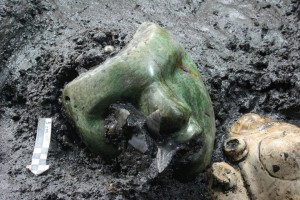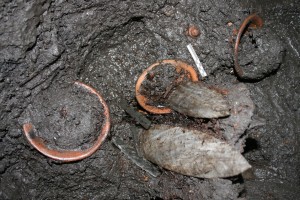 Archaeologists have discovered what they think are the original ceremonial offerings made by the builders of Teotihuacan’s Pyramid of the Sun before construction began around 50 A.D.
Archaeologists have discovered what they think are the original ceremonial offerings made by the builders of Teotihuacan’s Pyramid of the Sun before construction began around 50 A.D.
Using a 380-foot-long tunnel originally dug towards the center of the pyramid by archaeologists in the 1930s, researchers added an additional three short tunnels and dropped 59 exploratory shafts with the aim of reaching the foundational layer. The old tunnel turned out to stop just 20 feet west of the center, so the new extensions led archaeologists to the pre-construction base of the pyramid where they found the remains of three structures that pre-date the pyramid and the ceremonial offerings they were hoping to find.
The offerings found at the base of the pyramid in the Teotihuacan ruin site just north of Mexico City include a green serpentine stone mask so delicately carved and detailed that archaeologists believe it may have been a portrait.
The find also includes 11 ceremonial clay pots dedicated to a rain god similar to Tlaloc, who was still worshipped in the area 1,500 years later, according to a statement by the National Institute of Anthropology and History, or INAH.
The offerings, including bones of an eagle fed rabbits as well as feline and canine animals that haven’t yet been identified, were laid on a sort of rubble base where the temple was erected about A.D. 50.
“We know that it was deposited as part of a consecration ritual for the construction of the Pyramid of the Sun,” said INAH archaeologist Enrique Perez Cortes.
They also found seven human burials, some of them of infants, who were probably sacrificed in the same consecration ritual that claimed the animals’ lives. Obsidian artifacts were discovered in a variety of forms — projectile points, razors, anthropomorphic designs — along three large discs of pyrite. One of the pyrite discs is almost 18 inches in diameter, the largest ever found at Teotihuacan.
The exquisite serpentine mask was not the only stone mask. There were two other human figures found with shell and pyrite eyes. The greenstone mask is the most unusual, however, because of its top quality artistry and its relatively small size. It’s just over four inches square, smaller in dimension and volume than other Teotihuacan masks which have been discovered. Those masks are not carved in such detail, nor have they been found in a ritual context.
The city of Teotihuacan was founded by an unknown culture approximately 2,500 years ago. By the time the Aztecs settled in the area in the 1300s, the town had long since been abandoned. It was the Aztecs who named it Teotihuacan meaning “the place where men become gods.”

